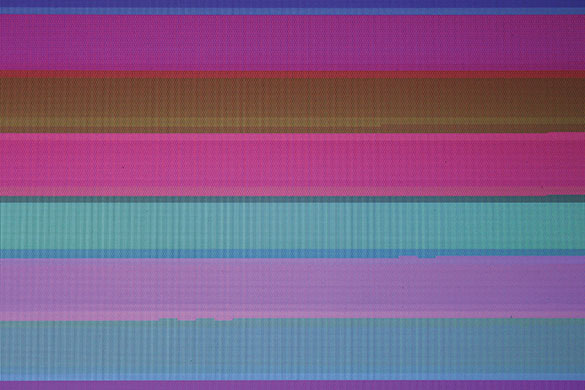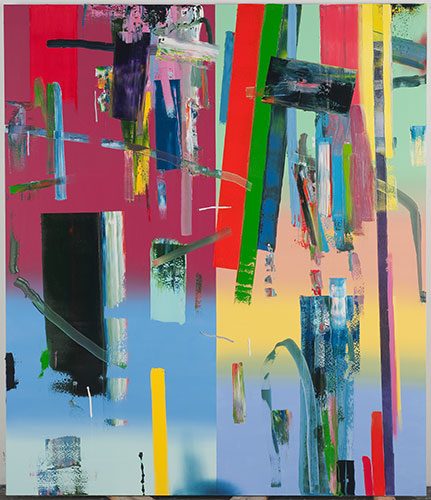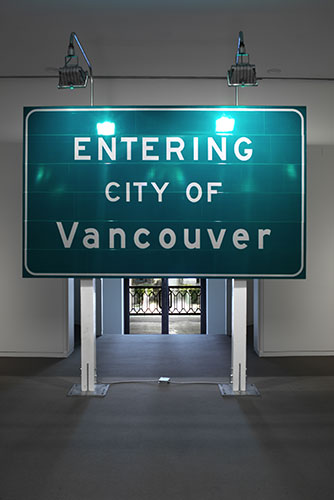Tomory Dodge, London
While LA-based painter Tomory Dodge has plunged into abstract territory, his dense tangles of paint still retain something of the chaotic wildernesses depicted in earlier works. Smears and blocks of luminous pigments amass like a flurry of city lights. In new diptychs and large-scale paintings he explores symmetry, with the frame divided in two to create mirror worlds of curiously balanced frenzy.
Alison Jacques, W1, to 24 Apr
Ron Terada and Susan Collis, Birmingham
Ron Terada's neon works stand like deadpan provocations for road-movie reveries. A towering aluminium sign reading Entering City of Vancouver is set against a series of posters for group exhibitions by local artists. A neon Big Star sign is directly lifted from the logo of the cult rock band of the same name, who in turn lifted it from a supermarket chain. Susan Collins's installations initially appear to be in process of construction. On closer observation, however, we see that the old table spattered with paint is inlaid with pearls and opals; the paint-stained dust sheet is painstakingly embroidered; and there are nails of gold and silver. Enchanting stuff, playing at the age-old art of making magic of the mundane.
Ikon, Wed to 16 May
Robert Clark
Anna Maria Maiolino, London
Sao Paulo-based artist Anna Maria Maiolino is hand-rolling several thousand kilos of clay into hundreds of balls, which will be left to dry out and crumble, bearing the marks of kneading fingers like a stigmata to artistic industry. As physically impressive as the project promises to be, though, Maiolino seems more interested in the act of making, rather than any final result. The mass of sculptures allude to social structures, and the interplay between individuals and culture. Like peers Lygia Clark and Hélio Oiticica, her work has developed through the object-suspicious ethos of feminism and conceptual art. While she has worked with clay since 1989, several of her films included in this show reveal her as a polymorphous artist.
Camden Arts Centre, NW3, Fri to 30 May
Vertical Thoughts, Dublin
Subtitled Morton Feldman and the Visual Arts, this show charts the influence of the American composer on some of the most innovative visual artists of the 1960s and 70s, and vice versa. Feldman's "indeterminate" music has more in common with the open-ended colour fields of abstract painting than it does with the melodic linear structures of more traditional composers of the time. The show includes works by such pioneering visual art colleagues as Jasper Johns, Robert Rauschenberg and Cy Twombly. It's an engrossing reminder of one of the most exciting concentrations of artistic talent in the 20th century.
Irish Museum of Modern Art, Wed to 27 Jun
Robert Clark
Ilya and Emilia Kabakov, London
It's not hard to tell from Ilya Kabakov's work that he came of age in Soviet-era Russia. In his installations, impossible wishes are piled optimistically high, tempered by a hollow foreboding of failure. He has collaborated with his wife, Emilia, since 1989 on projects such as Palace for Projects (1998) and House of Dreams (2005). But the Kabakovs also work on a smaller scale, as demonstrated in the Malevich-inspired Flying Paintings on show here. Slanting geometric shapes contain happy, idealised scenes of outdoor gatherings and homely repose that threaten to slide off the canvas.
Sprovieri Gallery, W1, Tue to 29 May
Skye Sherwin
Francis Bacon, Compton Verney
Francis Bacon: In Camera sets unforgettable paintings from 1944 to 1989 against the photographs the artist so often used as catalytic source material. On loan from the archives of Dublin City Gallery, The Hugh Lane, many of the images are soiled and distressed by the prevailing organised chaos of Bacon's studio. But the smooth surfaces of powerful photo-images by the likes of Eadweard Muybridge and John Deakin are further distorted and transformed by Bacon's messing with the oil paint. It's as if the artist needed the fixed certainties of the photographs to anchor his wayward, grotesque figures in real life. This, after all, is the thing Bacon was a master of: setting up poignant visual and psychological tensions between fierce passion and provocative restraint.
Compton Verney, Sat to 20 Jun
Tim Head, Cambridge
Back in 1977, when Tim Head was the first artist fellow at Kettle's Yard, he had been doing disorienting things with mirrors and projections. Gallery walls were transformed into uncertain shifting surfaces with little more than reflections and light. Now, Head returns to the gallery as one of Britain's foremost innovators of digital art. Having developed his fascination for space through the logos and gizmos of consumer culture, evolving media and new technology, he has turned his attention now to computer pixels. Typically blown up large and projected in changing constellations, his recent works are kaleidoscopic and mesmerising, as if a Jackson Pollock painting had been created by 2001's supercomputer Hal in introspective mood.
Kettle's Yard, to 9 May

Simon Faithfull, Preston
If Simon Faithfull's drawings and video installations are exploratory, it's because the process of exploration itself is being explored. A record of the artist's trip to the Arctic Circle, here viewed as a series of reflections captured in a human eye, includes a fascinating array of wild locations and complex scientific gadgetry. But the supposed object of the artist's exploration – the northern lights – are nowhere to be seen. Elsewhere, a lone figure is tracked by video camera as he uses a GPS device to follow the exact route of the Greenwich meridian from Peace Haven in Hampshire to Cleethorpes in Lincolnshire. Streams are waded through, windows and hedges climbed; but the point of it all is left up the air. There's an absurdist edge to all that Faithfull does, plus an obsessive and quixotic love of travel and random observation.
Harris Museum and Art Gallery, to 5 Jun






masterpieces are somehow accidental, they are created we can imagine by the subconscious which is the objective realm. in this respect they are closer to reality than what most conscious mind pretend to acknowledge. a conscious image is often on your subconscious and here Ben does the job. hopefully we can all become aware of the unity and aim of art itself which is nothing more than the common wellbeing of all of us. therefore art is the path to evolution, revolution and contentment.
ReplyDelete